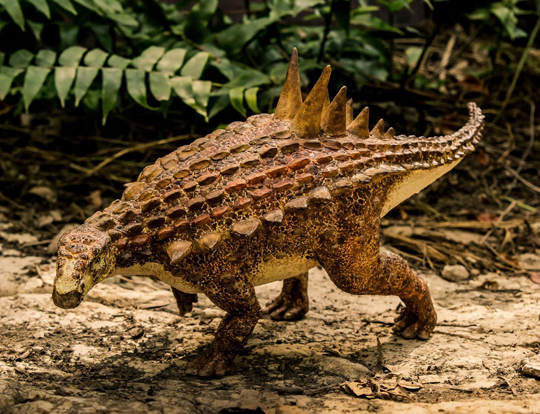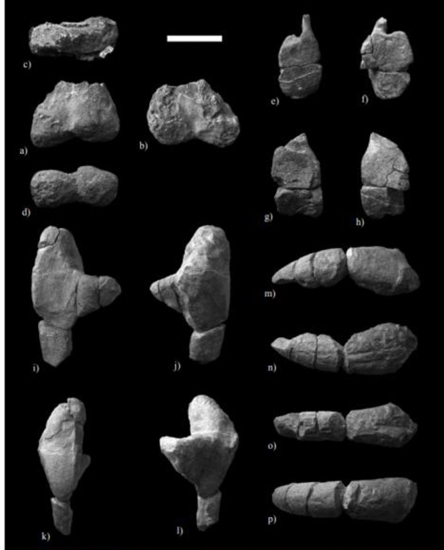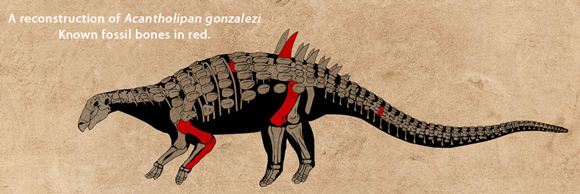Mexico’s Oldest Member of the Ankylosauria
Acantholipan gonzalezi – Coahuila’s Oldest Dinosaur
A new genus of armoured dinosaur has been described. This dinosaur roamed northern Mexico around 85 million years ago (the Santonian faunal stage of the Late Cretaceous). Described as a nodosaurid, the dinosaur has been named Acantholipan gonzalezi and it is the oldest dinosaur described to date from the Coahuila region of Mexico.
Acantholipan gonzalezi
Its discovery is no real surprise, some osteoderms (dermal armour), associated with ankylosaurids have been described from the geologically younger (Campanian), Cerro del Pueblo Formation exposed in the Coahuila region. In addition, a single tooth identified as nodosaurid, has been discovered in the Mexican state of Baja California. This fossil tooth was found in Campanian-aged deposits. Palaeontologists had expected that armoured dinosaur fossils would be found elsewhere in Mexico, extending their known range further south.
The Southernmost Nodosaurid from North America – Acantholipan gonzalezi
Picture credit: Museo del Desierto (Mexico)
Identified from Fragments of Bone
Fragmentary fossils found near to the city of Ocampo in northern Mexico, back in 2011, suggested that nodosaurids roamed this part of North America during the Late Cretaceous, but it was thought that the fossil material was not sufficient to support the establishment of a new species. The fossils consist of a single dorsal vertebra, a tail bone (caudal vertebra), a partial ulna, a fragment of rib, one large spike (osteodermal spine) along with a portion of an upper arm bone (distal end of a humerus).
The Fragmentary Fossil Material (CPC 272)
Picture credit: Museo del Desierto (Mexico)
The photograph (above), shows the nodosaurid fossil material from Coahuila. Although very fragmentary, subsequent comparative analysis with younger North American nodosaurids has permitted the establishment of a new species.
Key
Distal end of right humerus in (a) dorsal, (b) ventral, (c) anterior, and (d) posterior views.
Dorsal vertebra in (e) cranial, (f) caudal, and (g-h) lateral views.
Right ulna in (i) dorsal, (j) ventral, and (k-l) lateral views.
Osteodermal spine (m-p).
Note: Scale bar = 5 centimetres
A Skeletal Reconstructioni of Acantholipan gonzalezi
A Skeletal Illustration of A. gonzalezi – Known Fossil Material Outlined in Red
Picture credit: Museo del Desierto (Mexico)
An Armoured Dinosaur from Marine Shales
The fossil material was discovered in marine shales associated with the Pen Formation. The research team studying this material have concluded that the carcass of the dinosaur, a juvenile approximately 3.5 metres long, had been swept out to sea, before sinking to the seafloor and becoming buried by sediment. If this dinosaur had reached maturity, the scientists estimate that it could have reached a length of about six metres and weighed several thousand kilograms.
With the naming of Acantholipan gonzalezi, this dinosaur becomes the oldest member of the Dinosauria described from the Coahuila region, and the first member of the Ankylosauria clade to have been named from Mexican fossils.
Commenting on the new species of armoured dinosaur, José Rubén Guzmán Gutiérrez of the Museo del Desierto and one of the co-authors of the scientific paper describing the dinosaur in the Swiss Journal of Palaeontology, stated:
“Here in Mexico, we have a significant palaeontological wealth, specifically in the state of Coahuila. We have this palaeontological richness and it is worthwhile for the population to get involved in getting to know this heritage that belongs to all Mexicans.”
The name of this new species of armoured dinosaur honours its Mexican roots. The genus name comes from the Greek “akanthos”, which means spine, combined with the name of the native Indians which inhabited this part of northern Mexico. The species name honours Arturo González-González, the director of the Museo del Desierto.
To read an article from 2017 reporting on the discovery of a new species of horned dinosaur from the Coahuila region of Mexico: Yehuecauhceratops – A New Horned Dinosaur from Northern Mexico.




